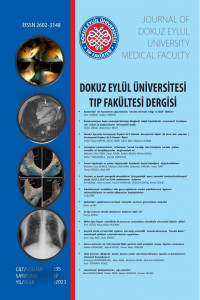Öz
ABSTRACT
Introduction: Epicardial lipomatosis (EL) is an increase in adipose tissue in the
epicardial space. This study aimed to evaluate cardiac magnetic resonance
imaging (CMR) findings and their effects on cardiac functions in patients with
EL.
Methods: A total of 33 adult patients with detected EL were evaluated
retrospectively. Patients were evaluated with right ventricular (RV) enddiastolic diameter (ED), RV ejection fraction (EF), left ventricular (LV) ED,
LVEF, LV stroke volume, LV cardiac output, and LV cardiac index.
Measurements were repeated intraobserver. Maximum epicardial fat thickness
(EP) was measured from the thickest place in 2 and 4 chamber images. Data
were compared with paired student t-test after the Kolmogorov-Smirnov
normality test. EP and ventricular measurements were compared using
Pearson's correlation coefficient.
Results: The RVED (r = 0.39), right ventricular ejection fraction (RVEF) (r =
0.35), and LVED (r = 0.31) data showed a moderate inverse correlation to the
increased EP. A low correlation was found between the increased EP and other
functional data of the right and left ventricles (r < 0.3). Intra-observer variability
was (2.9 and 6.8%).
Conclusion: The increase in epicardial fat thickness was determined to have a
low and moderate effect on the right and left heart functions.
Anahtar Kelimeler
Heart Magnetic Resonance Imaging Ventricular Function Pericardium Adipose tissue
Kaynakça
- Pruente R, Restrepo CS, Ocazionez D, Suby-Long T, Vargas D. Fatty lesions in and around the heart: a pictorial review. Br J Radiol. 2015;88(1051):20150157. doi:10.1259/bjr.20150157
Öz
Introduction: Epicardial lipomatosis (EL) is an increase in adipose tissue in the
epicardial space. This study aimed to evaluate cardiac magnetic resonance
imaging (CMR) findings and their effects on cardiac functions in patients with
EL.
Methods: A total of 33 adult patients with detected EL were evaluated
retrospectively. Patients were evaluated with right ventricular (RV) enddiastolic diameter (ED), RV ejection fraction (EF), left ventricular (LV) ED,
LVEF, LV stroke volume, LV cardiac output, and LV cardiac index.
Measurements were repeated intraobserver. Maximum epicardial fat thickness
(EP) was measured from the thickest place in 2 and 4 chamber images. Data
were compared with paired student t-test after the Kolmogorov-Smirnov
normality test. EP and ventricular measurements were compared using
Pearson's correlation coefficient.
Results: The RVED (r = 0.39), right ventricular ejection fraction (RVEF) (r =
0.35), and LVED (r = 0.31) data showed a moderate inverse correlation to the
increased EP. A low correlation was found between the increased EP and other
functional data of the right and left ventricles (r < 0.3). Intra-observer variability
was (2.9 and 6.8%).
Conclusion: The increase in epicardial fat thickness was determined to have a
low and moderate effect on the right and left heart functions.
Anahtar Kelimeler
Heart Magnetic Resonance Imaging Ventricular Function Pericardium Adipose tissue
Kaynakça
- Pruente R, Restrepo CS, Ocazionez D, Suby-Long T, Vargas D. Fatty lesions in and around the heart: a pictorial review. Br J Radiol. 2015;88(1051):20150157. doi:10.1259/bjr.20150157
Ayrıntılar
| Birincil Dil | İngilizce |
|---|---|
| Konular | Radyoloji ve Organ Görüntüleme |
| Bölüm | Araştırma Makaleleri |
| Yazarlar | |
| Yayımlanma Tarihi | 30 Ağustos 2021 |
| Gönderilme Tarihi | 27 Mart 2021 |
| Yayımlandığı Sayı | Yıl 2021 Cilt: 35 Sayı: 2 |

